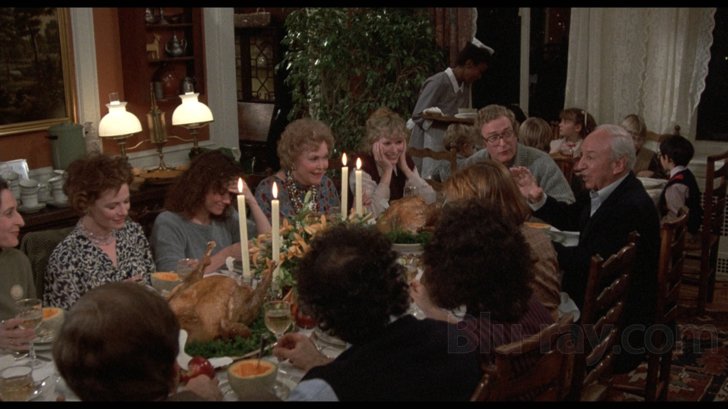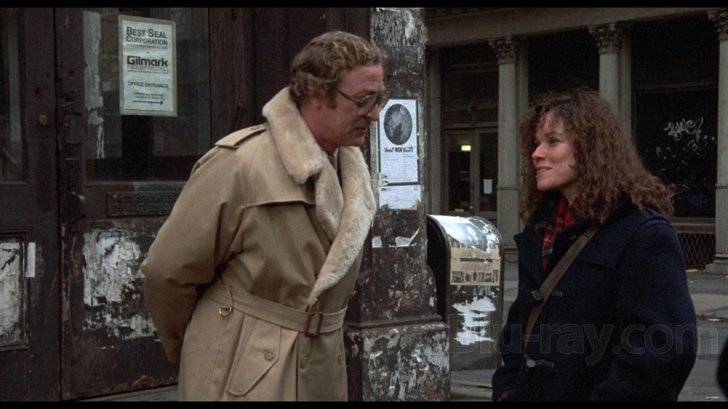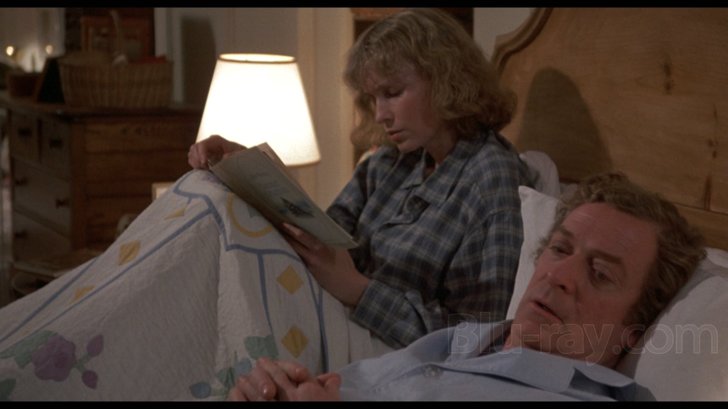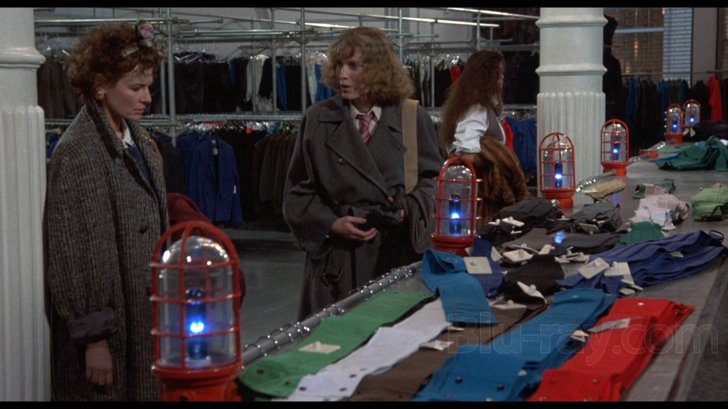Hannah and Her Sisters Blu-ray Movie
HomeHannah and Her Sisters Blu-ray Movie 
The Woody Allen CollectionMetro-Goldwyn-Mayer | 1986 | 107 min | Rated PG-13 | Jan 15, 2013

Movie rating
8 | / 10 |
Blu-ray rating
| Users | 4.5 | |
| Reviewer | 4.0 | |
| Overall | 4.0 |
Overview
Hannah and Her Sisters (1986)
Three sisters deal with their tangled relationships amidst the wonders of New York City.
Starring: Mia Farrow, Dianne Wiest, Michael Caine, Barbara Hershey, Carrie FisherDirector: Woody Allen
| Drama | 100% |
| Romance | 47% |
| Comedy | Insignificant |
Specifications
Video
Video codec: MPEG-4 AVC
Video resolution: 1080p
Aspect ratio: 1.85:1
Original aspect ratio: 1.85:1
Audio
English: DTS-HD Master Audio Mono (48kHz, 24-bit)
Spanish: Dolby Digital Mono
French: Dolby Digital Mono
Subtitles
English SDH, Spanish
Discs
25GB Blu-ray Disc
Single disc (1 BD)
Playback
Region free
Review
Rating summary
| Movie | 4.5 | |
| Video | 3.0 | |
| Audio | 3.5 | |
| Extras | 0.5 | |
| Overall | 4.0 |
Hannah and Her Sisters Blu-ray Movie Review
Families and Their Discontents
Reviewed by Michael Reuben January 20, 2013Hannah and Her Sisters won Woody Allen his second Oscar for original screenplay. (The first was for Annie Hall, and the third was for Midnight in Paris.) Two members of its talented ensemble cast, Michael Caine and Dianne Wiest, walked away with supporting actor Oscars, and the film was nominated for best picture, director, editing and art direction. The film was also one of Allen's biggest hits with audiences, helped in no small part by its upbeat ending that found all of the members of the title character's extended family ready to sit down to a Thanksgiving dinner together, the many trials and tribulations of the previous 107 minutes seemingly a thing of the past. (I assure you that's not a spoiler.) Allen has repeatedly said that Hannah came out wrong and that it wasn't supposed to be a feel-good film. Some have claimed that he rewrote the ending to be more upbeat at the studio's request, but Allen had long passed the point where he bent to studio influence. (How else to explain Interiors and Stardust Memories?) It's more likely that the film's apparently happy ending flowed naturally both from the structure of its story, which Allen borrowed from Bergman's Fanny and Alexander, and from the warmth of key performances by Caine, Wiest, Mia Farrow and Barbara Hershey. Whatever their characters' missteps, these actors made them so irresistibly winning that audiences couldn't help but want to see them come out all right. Besides, what viewer isn't a sucker for the sight of three generations of a squabbling family coming together for a moment of respite so that they can gather peacefully around a communal table? Allen's angst-ridden pessimism, voiced by his character Mickey Sachs in the film, never had a chance.

Hannah takes place over a period of two years marked by three Thanksgiving celebrations at the Manhattan apartment of Hannah (Farrow) and her second husband, Elliot (Caine), a financial planner. The film is a multi-stranded narrative composed of multiple subplots, but one of the signal achievements of Allen's script and Susan E. Morse's seamless editing is that the separate stories always feel like parts of a whole. Although it's never clearly stated, Hannah is obviously the eldest of three sisters. The younger two are Holly (Wiest) and Lee (Hershey), neither of whom is settled in life. Lee lives with a much older artist, Frederick (Max von Sydow), a misanthrope who can't even put on enough of a front to join Lee at her family dinner. Holly is trying to make it as an actress, but without success, and she's constantly forced to borrow money from Hannah. Even more irksome to Holly is the fact that Hannah abandoned a budding career on stage to raise children and then, as soon as her kids were old enough, was immediately able to return to acting as the lead in a revival of A Doll's House. In an effort to support herself, Holly starts a catering service with her friend, April (Carrie Fisher), but the "Stanislavsky Catering Company" (named after the famous acting teacher) eventually comes to ruin over a romantic rivalry between the two partners over a charming architect named David (Sam Waterston, uncredited). Missing from Thanksgiving dinner is Hannah's first husband, Mickey Sachs (Allen), a harried writer for TV whose life is one long headache. (Look for numerous familiar faces on Mickey's staff, including John Turturro, Lewis Black, Julia Louis-Dreyfus and, as his long-suffering assistant, Julie Kavner.) Mickey spends the first part of the film getting tested for what he's certain is a fatal brain tumor, and the second part, after he's given a clean bill of health, in despair over the realization of his mortality. His morbid hypochondria wasn't even why he and Hannah broke up. Their marriage foundered on their inability to have children together (which is a simplified version of a riotously more bizarre tale). But the most dramatically extended and emotionally involving story is that of Hannah's current husband, Elliot, who develops a romantic fixation on his wife's younger sister, Lee, that threatens to tear apart both his marriage and his wife's family. Caine gives a bravura performance as a man driven to clumsy and ridiculous extremes by passion, guilt, joy and self-loathing. He's matched by Hershey's Lee, who was already confused enough in her relationship with the cantankerous Frederick before Elliot came along to stir the pot. As these two first circle, then fly toward each other, the emotional waves of their infidelity jostle their own significant others, as well as Holly, who is too self-absorbed even to notice what's happening. An unhappy family starts with the parents. In a few efficient scenes, Maureen O'Sullivan (Mia Farrow's real-life mother) and Lloyd Nolan (who died shortly after completing the film) sketch an indelible portrait of a show business couple, Norma and Evan, who, as Hannah says, loved the idea of having children but weren't interested in raising them. Alternately comrades in arms and deadly combatants, Norma and Evan failed to provide their daughters with any sense of stability. It was left to Hannah to do that for her sisters. But who provides it for Hannah? Elliot was supposed to and is failing miserably. A famous scene occurs near the end of the film, when Mickey runs into Holly at the (now-defunct) Tower Records store near Lincoln Center. After Hannah divorced Mickey, she set him up on a disastrous date with Holly, and the two of them, now sadder and wiser, reminisce in gently self-mocking tones about how badly mismatched they were. Hanging over the conversation is the question of whether we really do learn from our mistakes or just keep repeating them in new and different ways. The same question hovers in the background of the Thanksgiving celebration that closes the film. Because we want to believe in progress as much as happy endings, we privately collude with the characters on the screen to believe that they've finally grown up. But have they really?
Hannah and Her Sisters Blu-ray Movie, Video Quality 

Hannah and Her Sisters marked the beginning of Allen's collaboration with Italian cinematographer Carlo Di Palma, which produced twelve films. Di Palma's subdued hues and painterly compositions suited the more elaborate and often interior dramas for which Allen often aimed in this middle period of his career, frequently with mixed results (though how much of that was due to audience expectation is difficult to measure). MGM's 1080p, AVC-encoded Blu-ray of Hannah is something of a mixed affair. The bulk of it reproduces Di Palma's soft lighting and shaded textures with excellent detail, good color fidelity, deep blacks and an accurately rendered grain pattern that is reasonably unobtrusive. In about 15-20% of the shots, however—and there seems to be no pattern as to which ones—a noticeable amount of video noise is present, and it's sufficient to be a minor distraction. I stress that this is not film grain being accurately represented; it's noise that has crept into the picture during the transfer from film to video, and while it may result from aspects of the original photography (such as oddities of light or diffusion), it still doesn't belong there. Its presence is preferable to the indiscriminate application of noise reduction, but the digital tools exist to remove it without stripping away picture detail, assuming that someone is willing to invest the time and money to do the work appropriately. Apparently the decision was made not to do so. For an especially obvious example, look at timemark 30:25, when Mickey first emerges from Mt. Sinai Hospital after being told that he needs a CAT scan. Other than this one problem, no other artifacts were in evidence. The 107-minute film fits comfortably on a BD-25, since the only extra is a trailer.
Hannah and Her Sisters Blu-ray Movie, Audio Quality 

Hannah's soundtrack, presented in lossless DTS-HD MA 1.0, is another of Allen's lucid and effective mono mixes, with clear dialogue and a beautifully rendered musical soundtrack that is dominated by two songs that recur throughout the film. The first is the Rodgers and Hart tune, "Bewitched, Bothered and Bewildered" from Pal Joey; the other is "You Made Me Love You" by McCarthy and Monaco. These are obviously germane to the subplot involving Elliot and Lee, but they have a broader applicability as well, since the unpredictability of relationships is a thematic element that runs through the entire film. Other tunes of the same vintage appear as appropriate, and they are all reproduced with fine fidelity and very good dynamic range.
Hannah and Her Sisters Blu-ray Movie, Special Features and Extras 

The disc's only extra is a trailer (1080p; 1.85:1, enhanced; 1:36), which is notable for containing a scene not in the film. It shows Carrie Fisher (as April) and Sam Waterston (as David) visiting an art gallery. Like Sleeper, the Blu-ray of Hannah and Her Sisters comes with a main menu. This is the second MGM/Fox BD-Java encoded disc that I have reviewed with this unexpected but welcome design, and I would like to see it signal a permanent change to this studio's approach to the user interface. While it's easy to dismiss complaints about the user interface as nitpicking, the fact remains that user-friendliness has always been one of Blu-ray's biggest challenges, and nowhere is the challenge greater than when BD-Java is included on a disc. My personal view is that it shouldn't be used at all, unless that disc contains special features that require it. In the alternative, if it is included, basic steps must be taken to ensure that it doesn't become an obstacle to the user's basic enjoyment of the film. MGM/Fox was one of the worst offenders in this regard, but with the simple inclusion of a main menu, they have begun to clean up their act.
Hannah and Her Sisters Blu-ray Movie, Overall Score and Recommendation 

It cannot be a coincidence that, on the eve of the Blu-ray release of the film containing Allen's portrayal of Mickey Sachs, probably his most notable hypochondriac, the New York Times invited him to write a guest column about hypochondria. The writer/director responded with a diverting bit of facetious reasoning denying that he suffers from hypochondria, because "my maladies are real". He is, he insisted, merely "an alarmist":
What distinguishes my hysteria is that at the appearance of the mildest symptom, let's say chapped lips, I instantly leap to the conclusion that the chapped lips indicate a brain tumor. Or maybe lung cancer. In one instance I thought it was Mad Cow.In a sly and indirect way, Allen has captured an intriguing quality about many of the characters in Hannah and Her Sisters. At the first sign of reversal, discontent or dissatisfaction in life, they assume the worst, panic and reach for the bottle, or fixate on their wife's sister, or radically change careers, or join the Catholic Church, or take some other impulsive action that defies rationality. Hannah is the only exception, and how she manages it remains a mystery. You see her a little differently every time you watch the film. Despite a less than ideal video presentation, highly recommended.
Similar titles
Similar titles you might also like

Manhattan
The Woody Allen Collection
1979

September
Limited Edition to 3000 - SOLD OUT
1987

Annie Hall
The Woody Allen Collection
1977

Crimes and Misdemeanors
1989

Another Woman
1988

Stardust Memories
1980

You Will Meet a Tall Dark Stranger
2010

Midnight in Paris
2011

Wonder Wheel
2017

The Landlord
1970

Zelig
1983

The Descendants
2011

Interiors
1978

Last Night
2010

The Brothers McMullen
Filmmakers Signature Series
1995

The Apartment 4K
1960

Alice
Limited Edition to 3000 - SOLD OUT
1990

Vicky Cristina Barcelona
2008

From the Terrace
Limited Edition to 3000
1960

To Rome with Love
2012